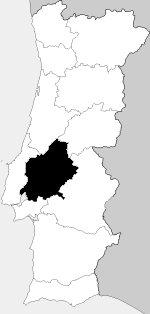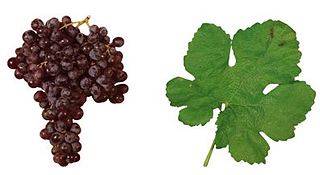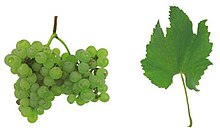
Portuguese wine is the result of traditions introduced to the region by ancient civilizations, such as the Phoenicians, Carthaginians, Greeks, and mostly the Romans. Portugal started to export its wines to Rome during the Roman Empire. Modern exports developed with trade to England after the Methuen Treaty in 1703. From this commerce a wide variety of wines started to be grown in Portugal. And, in 1758, one of the first wine-producing regions of the world, the Região Demarcada do Douro was created under the orientation of Marquis of Pombal, in the Douro Valley. Portugal has two wine-producing regions protected by UNESCO as World Heritage: the Douro Valley Wine Region and Pico Island Wine Region. Portugal has a big variety of local kinds, producing a very wide variety of different wines with distinctive personality.
Bairrada is a Portuguese wine region located in the Beira Litoral Province. The region has Portugal's highest wine classification as a Denominação de Origem Controlada (DOC), and its popularity has surged over the last years. It is small and quite narrow coastal region, part of the broader region of Beira Atlântico, and it is bordered to the northeast by the Lafões IPR and to the east by the Dão DOC.

Mencía, known as Jaen in Portugal, is a Spanish grape variety primarily found in the northwestern part of the country. It is planted on over 9,100 hectares, and it is primarily found in the Bierzo, Ribeira Sacra, Valdeorras and Monterrei regions.
Maria Gomes can refer to:
Almeirim is a Portuguese wine region centered on the town of Almeirim in the Ribatejo wine region. The region was initially a separate Indicação de Proveniencia Regulamentada (IPR) region, but in 2003, it became one of six subregions of the Ribatejo DOC, which has the higher Denominação de Origem Controlada (DOC) status. Its name may still be indicated together with that of Ribatejo, as Ribatejo-Almeirim.
Cartaxo is a Portuguese wine region centered on the town of Cartaxo and overlapping the Estremadura and Ribatejo VR regions. The region was initially a separate Indicação de Proveniencia Regulamentada (IPR) region, but in 2003, it became one of six subregions of the Ribatejo DOC, which has the higher Denominação de Origem Controlada (DOC) status. Its name may still be indicated together with that of Ribatejo, as Ribatejo-Cartaxo.
Coruche is a Portuguese wine region encompassing the town of Coruche in the Ribatejo region. The region was initially a separate Indicação de Proveniencia Regulamentada (IPR) region, but in 2003, it became one of six subregions of the Ribatejo DOC, which has the higher Denominação de Origem Controlada (DOC) status. Its name may still be indicated together with that of Ribatejo, as Ribatejo-Coruche.
Moura is a Portuguese wine region centered on the town of Moura in the Alentejo wine region. The region was initially a separate Indicação de Proveniencia Regulamentada (IPR) region, but in 2003, it became one of eight subregions of the Alentejo DOC, which has the higher Denominação de Origem Controlada (DOC) status. Its name may still be indicated together with that of Alentejo, as Alentejo-Moura.
Palmela is a Portuguese wine region centered on the town of Palmela in the Setúbal Peninsula subregion. The wine region has the Denominação de Origem Controlada (DOC) status after having been elevated from its former Indicação de Proveniencia Regulamentada (IPR) status. At the same time, the former Arrábida IPR, centered on the Arrabida hills, was absorbed into Palmela DOC.

The Pico IPR is a Portuguese wine region located on the island of Pico in the Portuguese archipelago of the Azores. The region is designated a second-tier Indicação de Proveniencia Regulamentada (IPR) classification, and potentially may be reclassified as a product of Denominação de Origem Controlada (DOC).
Tomar is a Portuguese wine region centered on the town of Tomar in the Ribatejo region. The region was initially a separate Indicação de Proveniencia Regulamentada (IPR) region, but in 2003, it became one of six subregions of the Ribatejo DOC, which has the higher Denominação de Origem Controlada (DOC) status. Its name may still be indicated together with that of Ribatejo, as Ribatejo-Tomar.
Portalegre is a Portuguese wine region centered on the Portalegre municipality in the Alentejo wine region. The region was initially an Indicação de Proveniencia Regulamentada (IPR) region, then elevated to Denominação de Origem Controlada (DOC) status. In 2003, it became one of eight subregions of the Alentejo DOC. Its name may still be indicated together with that of Alentejo, as Alentejo-Portalegre.
Redondo is a Portuguese wine region centered on the Redondo municipality in the Alentejo region. The region was initially an Indicação de Proveniencia Regulamentada (IPR) region, then elevated to Denominação de Origem Controlada (DOC) status. In 2003, it became one of eight subregions of the Alentejo DOC. Its name may still be indicated together with that of Alentejo, as Alentejo-Redondo.
Moscatel de Setúbal is a Portuguese muscatel produced around the Setúbal Municipality on the Península de Setúbal. The region is known primarily for its fortified Muscat wines known as Moscatel de Setúbal. The style was believed to have been invented by José Maria da Fonseca, the founder of José Maria da Fonseca, the oldest table wine company in Portugal dating back to 1834. J.M. Fonseca company still holds a quasi-monopoly control over the production of Moscatel de Setúbal today.

Tejo, until 2009 named Ribatejo, is a Portuguese wine region covering the same areas as the Ribatejo Province. It takes its name from the river Tejo (Tagus). The entire region is entitled to use the Vinho Regional designation Tejo VR, while some areas are also classified at the higher Denominação de Origem Controlada (DOC) level under the designation DoTejo DOC. VR is similar to the French vin de pays and DOC to the French AOC.

Tinta Negra Mole is a red Portuguese wine grape commonly used in the production of Madeira. It is the most widely planted variety on the Madeira islands and is considered the industry's "workhorse grape".

The Açores VR is a Portuguese wine region located in the archipelago of the Azores. This region is classified as a Vinho Regional (VR), which corresponds to table wines with a geographical indication under European Union wine regulations, similar to a French vin de pays region.
Caíño blanco or Cainho branco is a white Spanish and Portuguese wine grape variety that is grown in northwest Spain and northern Portugal in a stretch of area between Vinho Verde and the Denominación de Origen (DO) of Rías Baixas. The grape is often confused for Albariño and in Vinho Verde it is sometimes known under the name Alvarinhão. While DNA profiling conducted in the early 21st century has shown that the two grapes are distinct varieties, the evidence has suggested that Caíño blanco maybe an offspring of Albariño from a natural crossing with the red Portuguese wine grape Azal tinto.





